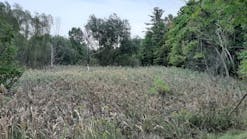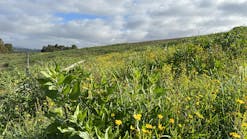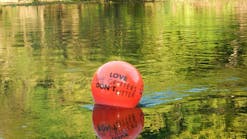The Right Choices Make Site Restoration Easier
Depending on the physical characteristics of a site, the best restoration method can range from direct seeding via a no-till drill to wet and dry broadcast application methods and accompanying amendments and mulch blends. Or, thanks to the helicopter, the material can even be placed without having to set foot on the site.
Aerial application success starts at the cellular level. “Rebuilding the biomass necessary for successful vegetation establishment can take many decades if left to nature alone,” states John Steinbacher of Summit Associates LC in Boise, ID. “Indigenous western plants will not establish without the symbiosis between the root systems of native plants and site-specific fungi and associated soil microbes. It’s that symbiosis that makes those plants tolerant to low nutrient levels, drought, high soil temperatures, heavy metals, soil salinity, soil toxins, fungal and bacterial root pathogens, and parasitic nematodes.
“We must set the stage for the natural reestablishment of mycorrhizal fungi, soil bacteria, and other beneficial soil organisms necessary to grow early serial stage plants, pioneer species that act as soil builders. This is done through the incorporation of certain organic complexes of humic acid, amino sugars, enzymes, and bacteria, along with protein-rich, organic-fiber nutrients, into the seedbed. We are stimulating the growth of soil organisms in order to nourish and sustain vegetative cover on-site through the stages of plant succession in our efforts to ultimately reestablish climax native plant species,” he explains.
Neglecting this crucial initial step, Steinbacher charges, means a contractor could have short-term greenery to show the client but fail to have a permanent cover. “To be successful using native species for revegetation and erosion control, it is imperative to focus on plant species, soil amendment materials, and techniques that facilitate the natural reestablishment and maintenance of site-specific mycorrhizae fungi and associated soil microbes.”
Since clients don’t have eons of time to allow this to happen naturally, the revegetation expert must include specific humic-substance-based organic matter in the soil amendment blend in order to jump-start the process, making it possible for the plants to survive until they themselves begin providing decomposed tissues that will feed the site from then on. Steinbacher reminds, “Different humic substances contain a variety of complex organic compounds that vary greatly in their content. Sugars, starches, and simple proteins are easily utilized by soil microbes and are rapidly oxidized to provide energy for various microbial life forms in the soil, which in turn supply nutrients to plants through symbiotic association.”
These principles were used at the Princess Blue Ribbonmine site near Salmon, ID. Portions of this site were inaccessible to conventional hydroseed equipment. A specially equipped helicopter with a highly experienced pilot was brought in to assist VSI Seeding with completing the application process.
VSI contracted with pilot Dick Reeder of Reeder Flying Service out of Twin Falls, ID. Reeder has more than 16,800 hours of flight time. His self-designed mulch tank carries 1,000 lb. of hydroseeding blend, helping to speed aerial application. “The skill of the pilot is essential in successful aerial application,” Steinbacher observes.
“It went on rapidly,” he continues. “He kept high enough from the terrain that rotor wash did not disturb the mulch impacting the ground. In fact, with the design of his tank, rotor wash helps disperse the mulch and seed blend more evenly, more exactly. Dick applied a hydroseed blend of 1 ton per acre.”
The mix included Quattro Fertile-Fiber at 2,000 lb./ac., Quattro Kiwi Power at 5 gal./ac., Tackifibers 20 lb./ac., Atlas SoilLok 65 gal./ac., Enersol humic acid at 3 gal./ac., 200 lb./ac. of calcium, 60 lb./ac. of elemental sulfur, l lb./ac. of zinc, and a native seed blend supplied by Comstock Seed. The seed blend comprised site-specific pioneer species, including bluebunch wheat grass, mountain brome, slender wheatgrass, Sanberg bluegrass, sheep fescue, blue fax, silky lupine, hairy vetch, Western yarrow, Pacific aster, mountain sagebrush, and rubber rabbit brush.
The mid-October project was a race against weather, with the pilot and his two-man crew winning. “He was able to make 15-foot swaths with minimum overlap. He covered a quarter acre per load, and it took just seven minutes from takeoff to return,” Steinbacher points out. The two-man crew premixed the material in a Finn 1500 HydroSeeder, and it took less than two minutes to transfer the material to the chopper’s tank. “So application averaged nine minutes per round trip or 30 minutes per acre.”
Thanks to aerial application, they got the material down on steep, inaccessible slopes just before winter closed in. “Like at Lost Trail and similarly treated sites in that area, we anticipate seeing very good results by May and midsummer. The pioneer species should establish well in the difficult-growth medium, given the combination of minerals and a specific humic-substances-based soil amendment package. Now Mother Nature can take hold, and over time the pioneer species will fade and climax species will come into the treated areas,” Steinbacher says.
Seeding by the Truckload on the Prairie
While aerial hydroseeding is still brand-new, standard hydroseeding began in 1953 when Charlie Finn invented the two-stage HydroSeeder unit that combined seed and water in one application. “When the Interstate system got its start and a lot of ground had to be reseeded quickly, it was Charlie who made it possible. His work paved the way for the contractors today, who can cover a full acre in just 10 to 15 minutes,” informs Wally Butman, director of marketing for Finn Corporation in Fairfield, OH. “Today it’s possible to put down seed, mulch, fertilizer, and a variety of soil amendments all in one move.”
What makes it easier is that hydroseeding carries a short learning curve. “Operators need to know what components they’re using. They need to know loading and discharging procedures for the machine involved and the application rates called for. The name of the game is growing grass,” Butman states.
Part of the challenge, of course, is putting down the mulch material along with the seed mix. “Hydromulching is a science and a seasoned contractor knows his rates for all components of the mix-all the variables that will influence a positive result,” Butman declares.
He adds that the rates can change considerably with the terrain. He recalls one upper-Midwest, 50-ac. roadside revegetation project of native materials. “Slopes were two-to-one or better, with an unstable soil condition. In addition, the potential for heavy rainfall boosted the need for an extra heavy application of mulch.” The soil tended to be silty loam with areas of clay and heavy rock.
“If he placed the material too lightly, there was a potential for serious erosion and having to redo failed areas troubled with sheet and gully erosion,” says Butman. “The contractor boosted his recommended by 70 percent-1,500 pounds-and put down more than 2,500 pounds of hydraulic mulch. He also added a powdered organic glue tackifier and fiber plus a mix of organic material and synthetic fibers.” The mulch blanket is formulated to break down by microbial action and exposure to the sun, yet it will last a number of months to ensure even revegetation while resisting erosion at the surface.
Butman emphasizes that the thick slurry covers better than conventional mulch. Further, he used a T-330 HydroSeeder, which could send the mix more than 230 ft. from the discharge nozzle, making it possible to reach the top of the terraces from the roadside. Total grass was established in less than three weeks.
He adds that today’s on-the-ground equipment makes it possible to discharge various mulch formulations more than 1,000 ft. from the parked truck. “But it takes a special progressing cavity pump for distances exceeding 1,000 feet through the hose.”But not every slope requires special equipment. After all, while most farming is done on less than a 15% slope, many farms do well with slopes greater than 20%. Those types of slopes can be reseeded with ground equipment, where the operator leaves the equipment only to double check rate and depth of seeding. What’s new is what is being planted in those areas with gentler slopes. “The North Carolina Department of Transportation truly is a leader in some of the reseeding and some wildflower seeding initiated in the mid-’80s,” states Andy Anderson, sales engineer for AGCO Corporation in Duluth, GA.
North Carolina and other states have taken what traditionally has been farm equipment, such as Tye NoTill seeding equipment, and adapted it for roadside erosion control projects. “What some states are looking for are replacement grasses, the kind that don’t have to be mowed every time it rains. Another strategy is to plant wildflowers, which don’t have to be mowed and are so beautiful it’s easy to sell them as a solution.”
Anderson, who has more than 30 years’ experience in revegetation, notes that wildflowers are particularly popular in North Carolina, Georgia, Alabama, Mississippi, Tennessee, Missouri, and Texas. “They’re reseeding along highways countrywide, but wildflowers tend to be popular south of I-80.”
Anderson also notes that reseeding efforts have been so successful in mining areas that some locales are more productive and colorful than they were before mining began. “Many use no-till reclamation drills to reseed native grasses as well as mixtures that include sagebrush and other native habitat upon which antelope and other animals graze. This reseeding is keeping the federal government happy and a lot of people employed.”
He observes, for example, that the Conservation Reserve Program involves more than 40 million ac. of highly erodible farmland. “A lot of reseeding is being done with no-till grass drills. Today there’s a big push to plant filter strips along streams, farm ponds, and waterways.”
While agreeing there are many, many mixes out there that today’s equipment can put down or blow down, Anderson offers this reminder, “You can’t trick Mother Nature. If they didn’t grow there to begin with, those varieties probably won’t prosper, no matter what kind of machine or care you used.”
He talks about principles involved in a reseeding project. “If weeds or an adverse crop is already there, you’ll want to control it. One important thing is that without prior tillage, you want to eliminate the competition. Today’s selective herbicides help you take care of that in a safe and efficient way. Now you can plant light, fragile varieties, whether they’re native grasses or wildflowers.”
Another principle is addressing soil compaction. After all, ground that’s easy to get on with a reseeding machine is easily overrun during construction, especially where the project right of way is narrow or tight. “You have to get rid of soil compaction problems,” Anderson advises.
He cites four steps to a successful no-till drill operation. “The first is accurate seed metering. Economics play a major role.”
“When you get into some specialized native wildflower seeds, they can run from 15 to 20 dollars per pound,” notes Don Lee, roadside operations engineer for the North Carolina DOT. “That’s 75 to 100 dollars per acre.” He adds that part of the strategy is to be sure the manufacturer’s seed box can handle the unusual shapes of these light, and often fluffy, seeds. “Otherwise you will have to broadcast the seed, which takes more time and more seed and could result in poor seed-to-soil contact.”
The second step is to open the seed track with a no-till coulter that reaches 1-2 in. into the ground, yet cuts seed tracks just wide enough for the seed to be buried less than 0.5 in. “Then use double disc openers found on grain drills to place it at the best seeding depth. With native grasses, that’s from zero to one-quarter inch. Wildflowers want a half inch. You want enough cover to prevent bird loss, rodent theft, and wind erosion,” Lee points out.
The final step is to be sure the depth-control press wheel is accurately set. “With narrow rows, you get a canopy quicker; you shade the ground to reduce moisture loss, suppress weeds, and keep the ground cooler. Plants don’t like hot feet. With no-till you’re promoting moisture and humus conservation, which means less maintenance or repair follow-up,” Lee explains.
In some cases, a flextine harrow behind the drill will redistribute the soil and surface residue, leaving a smoother surface. Anderson regards this as an insurance policy for optimizing what you’ve drilled. “Check for seed. If you don’t see an occasional seed atop the ground, that usually means the other 90 percent is far too deep.”
Now and then, a project may have a slope too steep for the tractor. Anderson has seen machinery taken on slopes greater than 1:1. “I recall the backside of a water reservoir where they took the seeder to the bottom of the slope and pulled it up the slope with a cable winch system.”
He also reports that airfields are ideal projects for no-till reseeding. “JFK in New York and BNA in Nashville reseed alongside the runways because of salt deicing contamination. They use native grasses and sometimes wildflowers. They want to be sure jet engines can’t pick up a loose or stray rock, because a rock sucked into a jet engine can cost a couple million dollars.”
Another product finding its way to North American slopes to help ensure successful reseeding projects is straw. Jim Tischer, speaking for RH Dyce Inc. in Winters, CA, notes, “Straw tubes are used in various applications all over the West for erosion and sediment control, slope stabilization, mine reclamation, construction site stormwater control, and forest-fire revegetation projects. A waste product in one industry, California rice farming, has found a ready use in another industry, erosion and sediment control, on a wide scale.” Rice is the preferred straw because it tends to be more weed-free than other straws.
Continues Tischer, “Particularly in the Bay Area of California, erosion and sediment control contractors are using straws as an integral part of their hydroseeding practices to help keep fragile soils in place during a major storm event. It’s a very effective best management practice for construction sites larger than 1 acre, where the California Bay Area Regional Water Quality Control Board enforcement practices have become more stringent.
“The less sediment a contractor has to remove after a storm event, the more cost-effective the project. Contractors and owners avoid notices of violations, fines, bad publicity, trauma, and possible construction delays.”
He recalls a Napa Valley vineyard that had removed the vines because of phytophera root rot. “The owner had a two-year wait before the 40-acre parcel could be replanted. The vineyard manager was concerned that native grasses would not adequately stabilize the soil, so he had the contractor use straw tubes. They put them on the slopes, then seeded over.” After two seasons, the vineyard soil has remained in place quite well.
Those 9-in.-diameter tubes, each measuring 25 ft. long, were installed 30 ft. apart on the contour. In just 10 days, a crew of eight installed the tubes by digging a 4-in.-deep trench, placing the straw tubes end to end, and staking every 4 ft. “Water runoff encounters the straw tube, stops and deposits any sediment next to the tube, then soaks in rather than running off uncontrolled. The straw tubes are like a series of mini-terraces and small sediment basins,” describes Tischer.
He adds, “Prime Napa vineyards currently sell for up to 40,000 dollars an acre, so the effort to safeguard the soil before the next planting is not an exercise. The goal is to maximize future agricultural use and minimize year-to-year expenses, including the cost of keeping soil in place.”
While much ado is made about reseeding, there are cases where the goal is to stabilize the ground-and prevent new growth. “New to the erosion control industry is the placement of a compost-fiber berm in lieu of plastic silt fencing. These berms are used on slopes up to two-to-one,” explains Dan Sutton, vice president of marketing for Rexius Express Blower in Eugene, OR. “In this case, the goal is to prevent new growth because of fire concerns.”
Seed or no seed, hydroblowing helps the operator get desired materials into areas that are difficult to get to by other methods. It may be that the slopes are too steep for machinery or the area includes buildings, trees, transmission lines, or other structures that make aerial application difficult. “Where needed, the operator can blow on 2 inches of compost for immediate erosion control, with seed in the mix for long-term vegetative control.”
Best of all, since no water is called for, weight is not as much of a problem. Operators can move about the area more quickly with a 5-in. hose than when pulling a hose filled with wet materials. “Our niche,” declares Rick Bean, “is going up a slope with a hose, not with a bucket of material that has to be dumped and raked.” Bean is division supervisor for Express Ground Cover for Diversified Landscape Company in Winchester, CA, and his company has two of Sutton’s machines.
Bean reports that their work along California freeways uses 70,000 yd.3/year. “One tractor-trailer holds 80 yards, while the other truck carries 50 yards.” He says the big concern is location. “Safety is our first worry. We close the freeway shoulder and our operators can pull the hose to wherever they need along the right of way, laying down 3 to 4 inches of weed suppresser, which helps to keep California roadsides decorative.
“On steeper slopes, it’s a matter of laying out the hose, connecting the sections, then hitting the remote control on the tool belt so you can spray downslope with the appropriate mix.” He adds that, thanks to safety measures, the work is rather routine. Sutton declares it takes but three to four days to learn the basics of the equipment. Then-as with any other art-practice, practice, practice is needed to hone that skill to perfection.
Thus, whether it’s a helicopter, hydromulching, no-till seeding, straw tubes, or blowing on dry materials, there are different answers for different challenges in restoring and stabilizing the American landscape.





